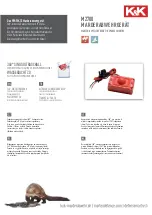
17
Operating notes
The original function of this socket was for “Direct
Servo Control”, and that’s why the abbreviation is still
in use. However, it is now much more versatile than
simply providing a means of controlling servos by ca-
ble. The DSC socket can now be used as an alterna-
tive to the Teacher socket (see pages 115 and 162),
also as an interface for fl ight simulators.
For the DSC connection to work you must check
the following:
1. Carry out any adjustments required in the approp-
riate menus:
If you are connecting the transmitter to a fl ight si-
mulator (for example), these settings are found in
the »
Modulation
« line of the »
Base setup mo-
del
« menu – “
PPM
” is usually required.
If you are connecting a Diagnosis lead (Order No.
4178.1
), the
modulation
must be selected to suit
the receiver – see below.
2.
Always
leave the
transmitter’s On / Off switch
in
the “
OFF
” position, for only at this setting is the RF
section of the transmitter module switched off (no
RF signal) even when the DSC lead is plugged in.
This is particularly important if you are using a Di-
agnosis lead, otherwise you could still cause inter-
ference to other pilots.
3. Connect the appropriate connecting lead to the
optional DSC socket on the back of the transmit-
ter. This renders the transmitter ready for use, cir-
cumventing the channel select process, and the
LCD screen operates. At the same time the let-
ters “
DSC
” appear on the LCD screen, instead of
the usual display of the transmission channel you
have selected.
4. Connect the other end of the connecting lead to
the desired piece of equipment, after referring to
the operating instructions supplied with it. If you
wish to use the Diagnosis lead, Order No.
4178.1
,
do not connect it directly to the receiver. First con-
DSC socket
Direct Servo Control
Environmental
protection notes
nect the lead to a receiver battery using a Y-lead
(Order No.
3936.11
or
3936.32
), and connect this
to the receiver’s battery input socket instead of the
receiver battery. The end with the barrel plug can
then be connected to the appropriate socket on
the back of the transmitter. Once the transmitter
is connected to the receiver as described above,
you can check the control functions or make chan-
ges to settings even if another pilot is using “your”
frequency. Since (power = “
OFF
”) the transmit-
ter does not broadcast a radio signal in this state,
you can, for example, prepare your model ready
to fl y without causing interference to other pilots.
Another advantage is that the transmitter’s current
drain is reduced to only about 70 mA, since the
transmitter’s RF section is not active in this mode
of operation. Diagnosis mode operations therefore
extend the operating time of the transmitter battery
considerably.
Important:
Ensure that all the cables are fi rmly plugged in.
Note regarding fl ight simulators:
The range of fl ight simulators available commercially
is now very wide, and you may fi nd that it is necessa-
ry to swap over certain contacts at the battery plug or
the DSC module. Do not attempt this work yourself; it
must be carried out by a GRAUPNER Service Centre.
Caution:
Certain receivers – such as the R16
SCAN
– feature
a battery socket to which a servo can also be con-
nected via a Y-lead. In this case it is not possible
to use a DSC lead.
Notes regarding environmental protection
Do not discard exhausted dry or rechargeable batte-
ries in the ordinary domestic refuse. As end-user you
are legally required (by the “Battery Regulation”) to
return old and exhausted dry cells and rechargeab-
le accumulators. For example, you can take them to
your local community recycling centre, or to any retail
outlet where batteries of the same type are sold.
The presence of this symbol on a pro-
duct, in the user instructions or the pa-
ckaging, means that you must not dispo-
se of that item, or the electronic compo-
nents contained within it, in the ordinary
domestic waste when the product comes
to the end of its useful life. The correct method of dis-
posal is to take it to your local collection point for re-
cycling electrical and electronic equipment. Dry cells
and rechargeable batteries must be removed from the
device and taken separately to a suitable battery dis-
posal centre.
Individual markings indicate which materials can be
recycled and re-used. You can make an important
contribution to the protection of our shared environ-
ment by re-using the product, recycling the basic ma-
terials or re-processing redundant equipment in other
ways.
If you don’t know the location of your nearest disposal
centre, please enquire at your local council offi ce.
Содержание MC-22S
Страница 1: ...1 mc 22s GB mc 22s 3D Rotary Programming System Programming manual ...
Страница 33: ...33 Digital trims ...
Страница 55: ...55 Program description Base setup model ...
Страница 77: ...77 Program description Flight phases ...
Страница 89: ...89 Program description Mixers ...
Страница 169: ...169 Approval certifi cates Conformity certifi cate EU conformity declaration Approval certificates Conformity Appendix ...
Страница 174: ...174 ...
Страница 175: ...175 ...
Страница 176: ...176 ...
Страница 177: ...177 ...
Страница 178: ...178 ...
















































